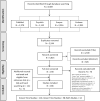Psychological impacts of "screen time" and "green time" for children and adolescents: A systematic scoping review
- PMID: 32886665
- PMCID: PMC7473739
- DOI: 10.1371/journal.pone.0237725
Psychological impacts of "screen time" and "green time" for children and adolescents: A systematic scoping review
Abstract
Technological developments in recent decades have increased young people's engagement with screen-based technologies (screen time), and a reduction in young people's contact with nature (green time) has been observed concurrently. This combination of high screen time and low green time may affect mental health and well-being. The aim of this systematic scoping review was to collate evidence assessing associations between screen time, green time, and psychological outcomes (including mental health, cognitive functioning, and academic achievement) for young children (<5 years), schoolchildren (5-11 years), early adolescents (12-14 years), and older adolescents (15-18 years). Original quantitative studies were identified in four databases (PubMed, PsycInfo, Scopus, Embase), resulting in 186 eligible studies. A third of included studies were undertaken in Europe and almost as many in the United States. The majority of studies were cross-sectional (62%). In general, high levels of screen time appeared to be associated with unfavourable psychological outcomes while green time appeared to be associated with favourable psychological outcomes. The ways screen time and green time were conceptualised and measured were highly heterogeneous, limiting the ability to synthesise the literature. The preponderance of cross-sectional studies with broadly similar findings, despite heterogeneous exposure measures, suggested results were not artefacts. However, additional high-quality longitudinal studies and randomised controlled trials are needed to make a compelling case for causal relationships. Different developmental stages appeared to shape which exposures and outcomes were salient. Young people from low socioeconomic backgrounds may be disproportionately affected by high screen time and low green time. Future research should distinguish between passive and interactive screen activities, and incidental versus purposive exposure to nature. Few studies considered screen time and green time together, and possible reciprocal psychological effects. However, there is preliminary evidence that green time could buffer consequences of high screen time, therefore nature may be an under-utilised public health resource for youth psychological well-being in a high-tech era.
Conflict of interest statement
The authors have declared that no competing interests exist.
Figures




References
-
- Bor W, Dean AJ, Najman J, Hayatbakhsh R. Are child and adolescent mental health problems increasing in the 21st century? A systematic review. Australian & New Zealand Journal of Psychiatry. 2014;48(7):606–16. - PubMed
-
- Kieling C, Baker-Henningham H, Belfer M, Conti G, Ertem I, Omigbodun O, et al. Child and adolescent mental health worldwide: evidence for action. The Lancet. 2011;378(9801):1515–25. - PubMed
Publication types
MeSH terms
LinkOut - more resources
Full Text Sources

